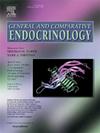促性腺激素释放激素 II 及其受体调节体外猪精子的运动、形态和运动学。
IF 1.7
3区 医学
Q3 ENDOCRINOLOGY & METABOLISM
引用次数: 0
摘要
第二种形式的促性腺激素释放激素(GnRH-II)及其受体(GnRHR-II)在猪睾丸内大量产生,并在精小管内免疫定位,表明在精子发生和/或精子功能中起作用。本研究的目的是量化猪生殖道组织中GnRH-II和GnRHR-II的丰度,并研究它们在猪精子功能中的作用。免疫印迹显示,睾丸内的GnRHR-II丰度是其他生殖器官的12倍(P < 0.0001)。在精管中,GnRHR-II显著地免疫定位于伸长的精细胞。在射精精子中,GnRHR-II免疫定位于连接片。在精浆中也检测到GnRH-II,可能起源于睾丸,因为与其他生殖组织相比,睾丸匀浆中的GnRH-II浓度最高(P < 0.0001)。为了评估GnRH-II/GnRHR-II对精子功能的影响,用GnRHR-II类似物处理延长的精液样本,并通过计算机辅助精子分析(CASA)进行评估。在实验1中,增加GnRHR-II激动剂(D-ala6 GnRH-II)浓度的精液处理表明,与对照剂处理的精液相比,两种浓度(0.1和100 µM)倾向于降低精子弯曲尾巴的百分比(P < 0.10)。在实验2中,增加GnRHR拮抗剂(SB-75/Cetrorelix)浓度的精液处理表明,与载体处理的样品相比,只有10 µM SB-75损害了CASA指标(P < 0.05)。在实验3中,100 µM D-ala6 GnRH-II和10 µM SB-75处理的精液部分恢复了精子的活力和形态测量。这些数据表明,GnRH-II及其受体以自分泌/旁分泌的方式调节猪精子功能。本文章由计算机程序翻译,如有差异,请以英文原文为准。

Gonadotropin-releasing hormone II and its receptor regulate motility, morphology, and kinematics of porcine spermatozoa in vitro
The second form of gonadotropin-releasing hormone (GnRH-II) and its receptor (GnRHR-II) are abundantly produced within the porcine testis and immunolocalize within the seminiferous tubules, suggesting a role in spermatogenesis and/or sperm function. The objective of this study was to quantify GnRH-II and GnRHR-II abundance within boar reproductive tract tissues and examine their role in porcine sperm function. Immunoblotting revealed GnRHR-II abundance was 12-fold greater (P < 0.0001) within the testis compared with other reproductive organs. Within seminiferous tubules, GnRHR-II prominently immunolocalized to elongating spermatids. In ejaculated spermatozoa, GnRHR-II immunolocalized to the connecting piece. GnRH-II was also detected in seminal plasma, likely originating from the testis as GnRH-II concentrations were greatest in testicular homogenates (P < 0.0001) compared with other reproductive tissues. To assess the effects of GnRH-II/GnRHR-II on sperm function, extended semen samples were treated with GnRHR-II analogues and evaluated via computer-assisted sperm analysis (CASA). In Experiment 1, semen treatment with increasing concentrations of GnRHR-II agonist (D-ala6 GnRH-II) revealed that two concentrations (0.1 and 100 µM) tended to decrease the percentage of bent sperm tails versus vehicle-treated semen (P < 0.10). In Experiment 2, semen treatment with increasing concentrations of GnRHR antagonist (SB-75/Cetrorelix) indicated that only 10 µM SB-75 impaired CASA metrics compared with vehicle-treated samples (P < 0.05). In Experiment 3, semen treatment with both 100 µM D-ala6 GnRH-II and 10 µM SB-75 partially rescued sperm motility and morphology measures. These data suggest that GnRH-II and its receptor regulate porcine sperm function in an autocrine/paracrine manner.
求助全文
通过发布文献求助,成功后即可免费获取论文全文。
去求助
来源期刊

General and comparative endocrinology
医学-内分泌学与代谢
CiteScore
5.60
自引率
7.40%
发文量
120
审稿时长
2 months
期刊介绍:
General and Comparative Endocrinology publishes articles concerned with the many complexities of vertebrate and invertebrate endocrine systems at the sub-molecular, molecular, cellular and organismal levels of analysis.
 求助内容:
求助内容: 应助结果提醒方式:
应助结果提醒方式:


